1997 MERCEDES-BENZ ML320 air condition
[x] Cancel search: air conditionPage 3390 of 4133
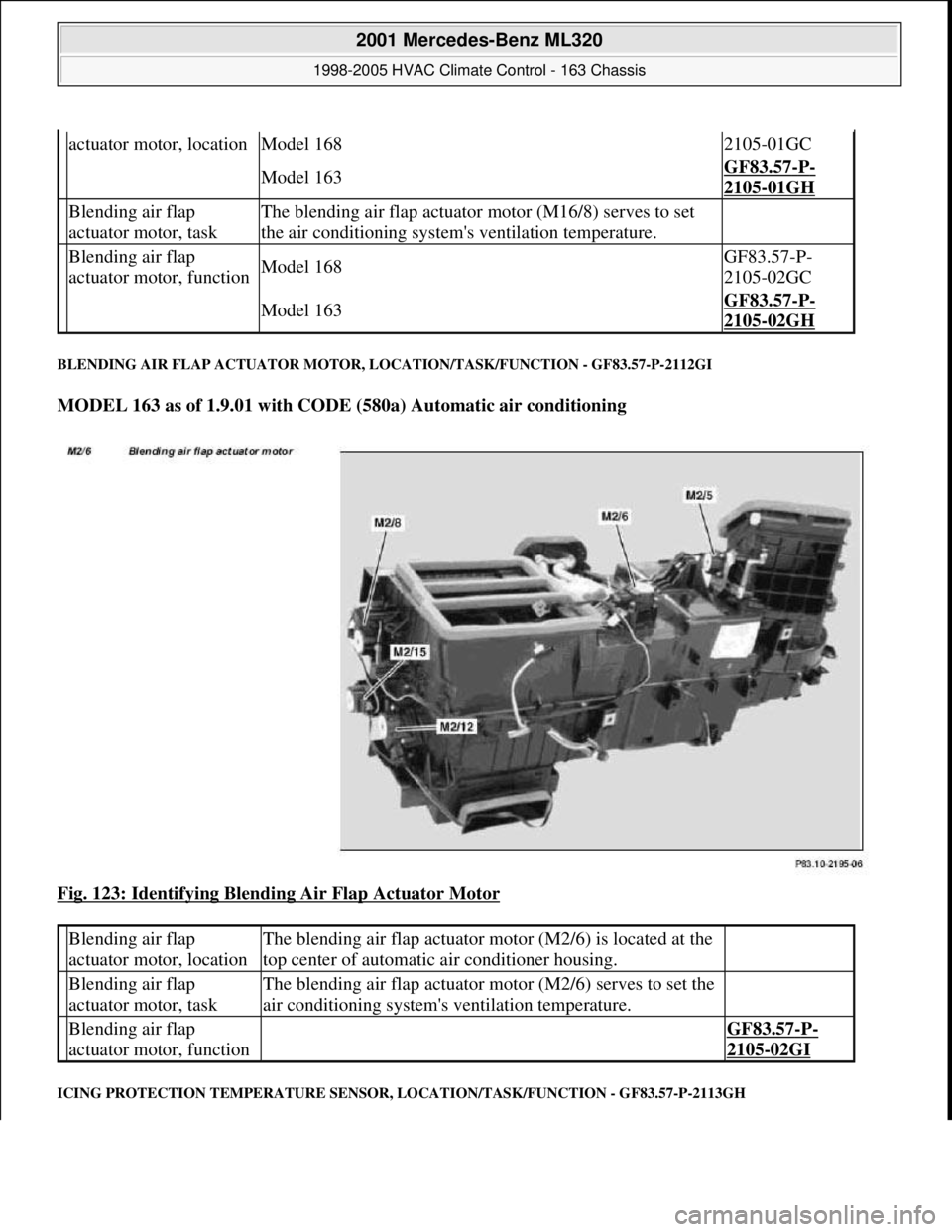
BLENDING AIR FLAP ACTUATOR MOTOR, LOCATION/TASK/FUNCTION - GF83.57-P-2112GI
MODEL 163 as of 1.9.01 with CODE (580a) Automatic air conditioning
Fig. 123: Identifying Blending Air Flap Actuator Motor
ICING PROTECTION TEMPERATURE SENSOR, LOCATION/TASK/FUNCTION - GF83.57-P-2113GH
actuator motor, locationModel 1682105-01GC
Model 163GF83.57-P-
2105-01GH
Blending air flap
actuator motor, taskThe blending air flap actuator motor (M16/8) serves to set
the air conditioning system's ventilation temperature.
Blending air flap
actuator motor, functionModel 168GF83.57-P-
2105-02GC
Model 163GF83.57-P-
2105-02GH
Blending air flap
actuator motor, locationThe blending air flap actuator motor (M2/6) is located at the
top center of automatic air conditioner housing.
Blending air flap
actuator motor, taskThe blending air flap actuator motor (M2/6) serves to set the
air conditioning system's ventilation temperature.
Blending air flap
actuator motor, function GF83.57-P-
2105-02GI
2001 Mercedes-Benz ML320
1998-2005 HVAC Climate Control - 163 Chassis
me
Saturday, October 02, 2010 3:23:17 PMPage 146 © 2006 Mitchell Repair Information Company, LLC.
Page 3391 of 4133
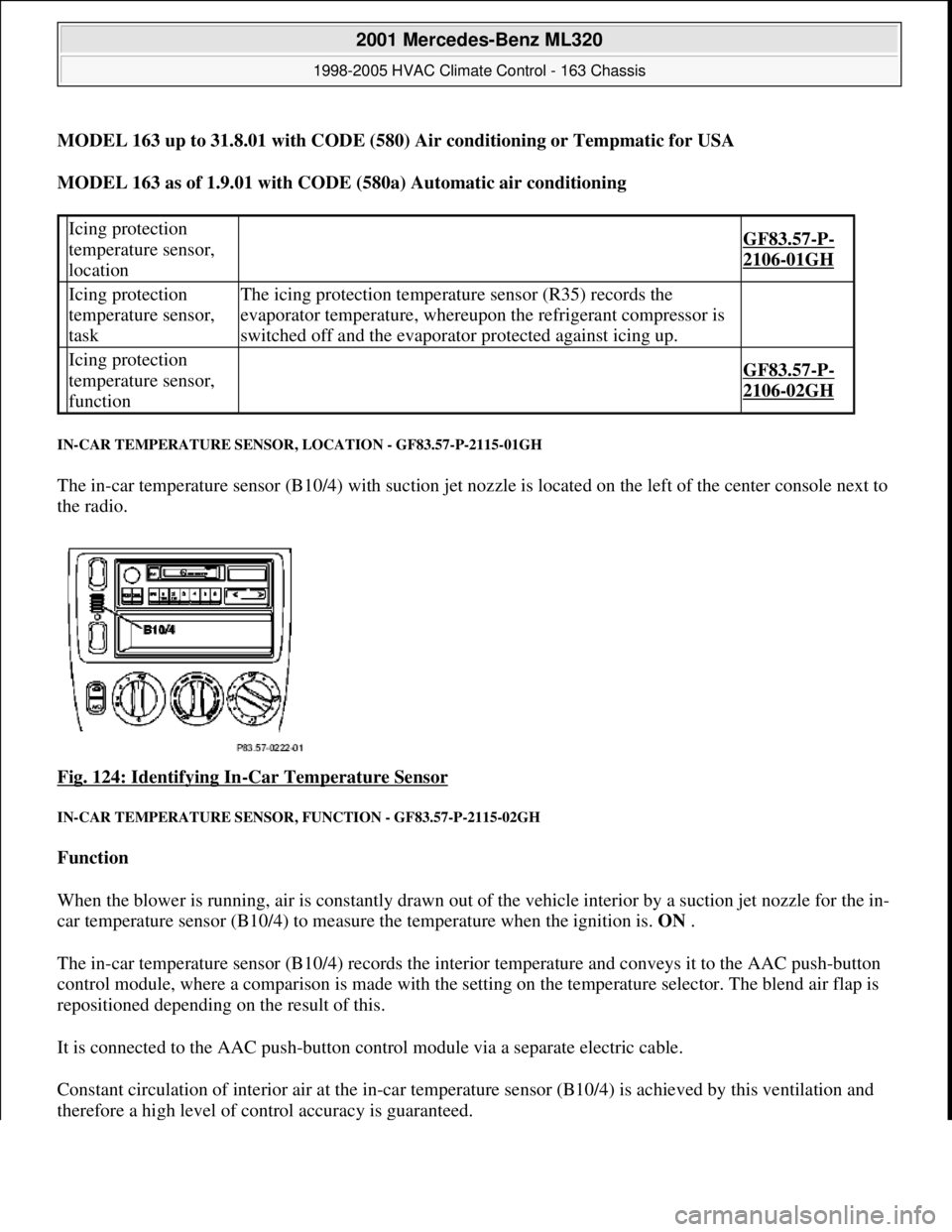
MODEL 163 up to 31.8.01 with CODE (580) Air conditioning or Tempmatic for USA
MODEL 163 as of 1.9.01 with CODE (580a) Automatic air conditioning
IN-CAR TEMPERATURE SENSOR, LOCATION - GF83.57-P-2115-01GH
The in-car temperature sensor (B10/4) with suction jet nozzle is located on the left of the center console next to
the radio.
Fig. 124: Identifying In
-Car Temperature Sensor
IN-CAR TEMPERATURE SENSOR, FUNCTION - GF83.57-P-2115-02GH
Function
When the blower is running, air is constantly drawn out of the vehicle interior by a suction jet nozzle for the in-
car temperature sensor (B10/4) to measure the temperature when the ignition is. ON .
The in-car temperature sensor (B10/4) records the interior temperature and conveys it to the AAC push-button
control module, where a comparison is made with the setting on the temperature selector. The blend air flap is
repositioned depending on the result of this.
It is connected to the AAC push-button control module via a separate electric cable.
Constant circulation of interior air at the in-car temperature sensor (B10/4) is achieved by this ventilation and
therefore a hi
gh level of control accuracy is guaranteed.
Icing protection
temperature sensor,
location
GF83.57-P-
2106-01GH
Icing protection
temperature sensor,
taskThe icing protection temperature sensor (R35) records the
evaporator temperature, whereupon the refrigerant compressor is
switched off and the evaporator protected against icing up.
Icing protection
temperature sensor,
function
GF83.57-P-
2106-02GH
2001 Mercedes-Benz ML320
1998-2005 HVAC Climate Control - 163 Chassis
me
Saturday, October 02, 2010 3:23:17 PMPage 147 © 2006 Mitchell Repair Information Company, LLC.
Page 3392 of 4133
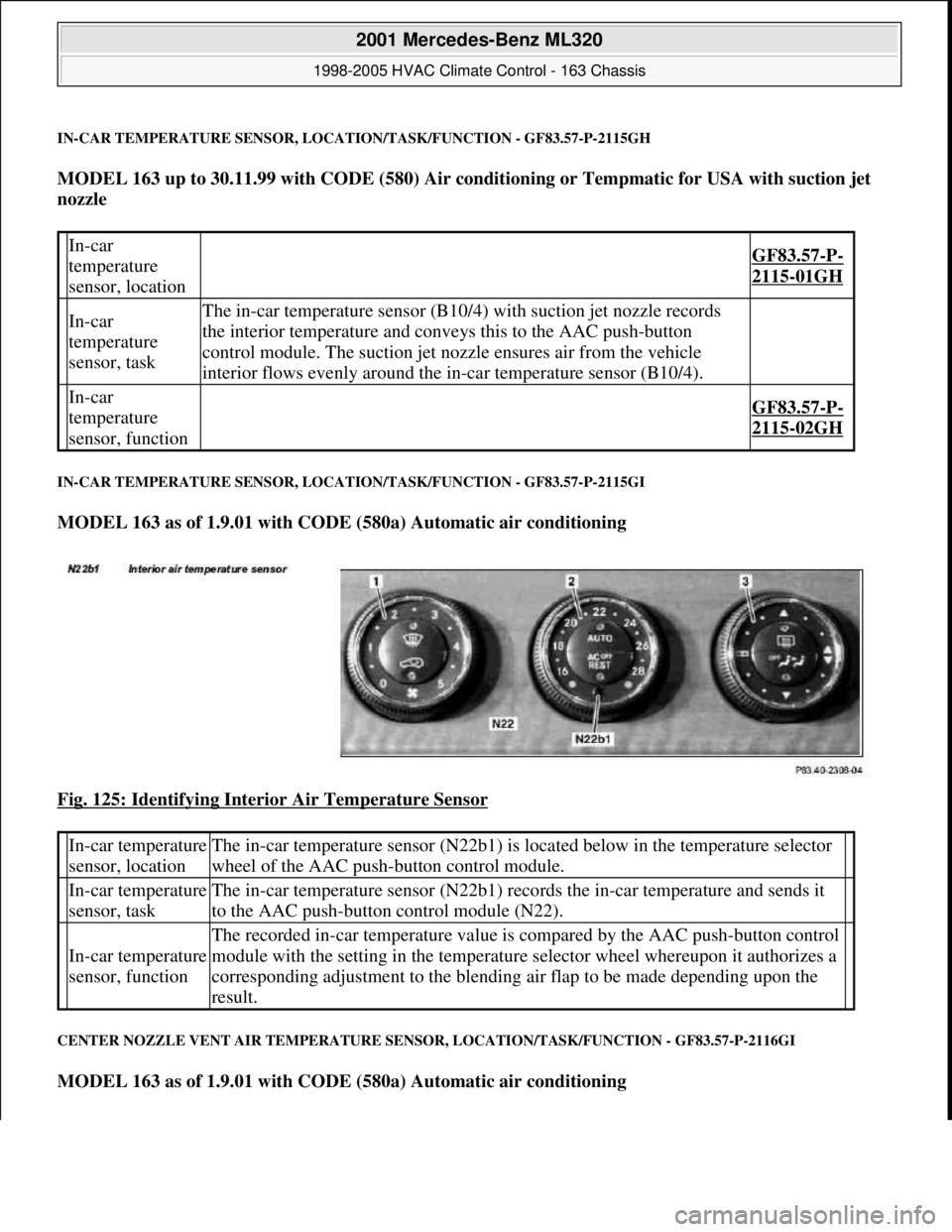
IN-CAR TEMPERATURE SENSOR, LOCATION/TASK/FUNCTION - GF83.57-P-2115GH
MODEL 163 up to 30.11.99 with CODE (580) Air conditioning or Tempmatic for USA with suction jet
nozzle
IN-CAR TEMPERATURE SENSOR, LOCATION/TASK/FUNCTION - GF83.57-P-2115GI
MODEL 163 as of 1.9.01 with CODE (580a) Automatic air conditioning
Fig. 125: Identifying Interior Air Temperature Sensor
CENTER NOZZLE VENT AIR TEMPERATURE SENSOR, LOCATION/TASK/FUNCTION - GF83.57-P-2116GI
MODEL 163 as of 1.9.01 with CODE (580a) Automatic air conditioning
In-car
temperature
sensor, location
GF83.57-P-
2115-01GH
In-car
temperature
sensor, taskThe in-car temperature sensor (B10/4) with suction jet nozzle records
the interior temperature and conveys this to the AAC push-button
control module. The suction jet nozzle ensures air from the vehicle
interior flows evenly around the in-car temperature sensor (B10/4).
In-car
temperature
sensor, function
GF83.57-P-
2115-02GH
In-car temperature
sensor, locationThe in-car temperature sensor (N22b1) is located below in the temperature selector
wheel of the AAC push-button control module.
In-car temperature
sensor, taskThe in-car temperature sensor (N22b1) records the in-car temperature and sends it
to the AAC push-button control module (N22).
In-car temperature
sensor, function
The recorded in-car temperature value is compared by the AAC push-button control
module with the setting in the temperature selector wheel whereupon it authorizes a
corresponding adjustment to the blending air flap to be made depending upon the
result.
2001 Mercedes-Benz ML320
1998-2005 HVAC Climate Control - 163 Chassis
me
Saturday, October 02, 2010 3:23:17 PMPage 148 © 2006 Mitchell Repair Information Company, LLC.
Page 3393 of 4133

Fig. 126: Identifying Center Nozzle Vent Air Temperature Sensor
FRONT FOOTWELL VENT AIR TEMPERATURE SENSOR, LOCATION/TASK/FUNCTION - GF83.57-P-2117GI
MODEL 163 as of 1.9.01 with CODE (580a) Automatic air conditioning
Center nozzle vent air
temperature sensor,
locationThe center nozzle vent air temperature sensor (B10/24) is located to the left of
the air duct's center nozzle below the instrument panel.
Center nozzle vent air
temperature sensor,
taskThe center nozzle vent air temperature sensor (B10/24) records the temperature
of the air flowing out of the center nozzle and sends it to the AAC push-button
control module (N22).
Center nozzle vent air
temperature sensor,
functionThe vent air's recorded temperature value is compared by the AAC push-button
control module (N22) with the setting in the temperature selector wheel
whereupon it authorizes a corresponding adjustment to the blending air flap to
be made depending upon the result.
2001 Mercedes-Benz ML320
1998-2005 HVAC Climate Control - 163 Chassis
me
Saturday, October 02, 2010 3:23:17 PMPage 149 © 2006 Mitchell Repair Information Company, LLC.
Page 3394 of 4133
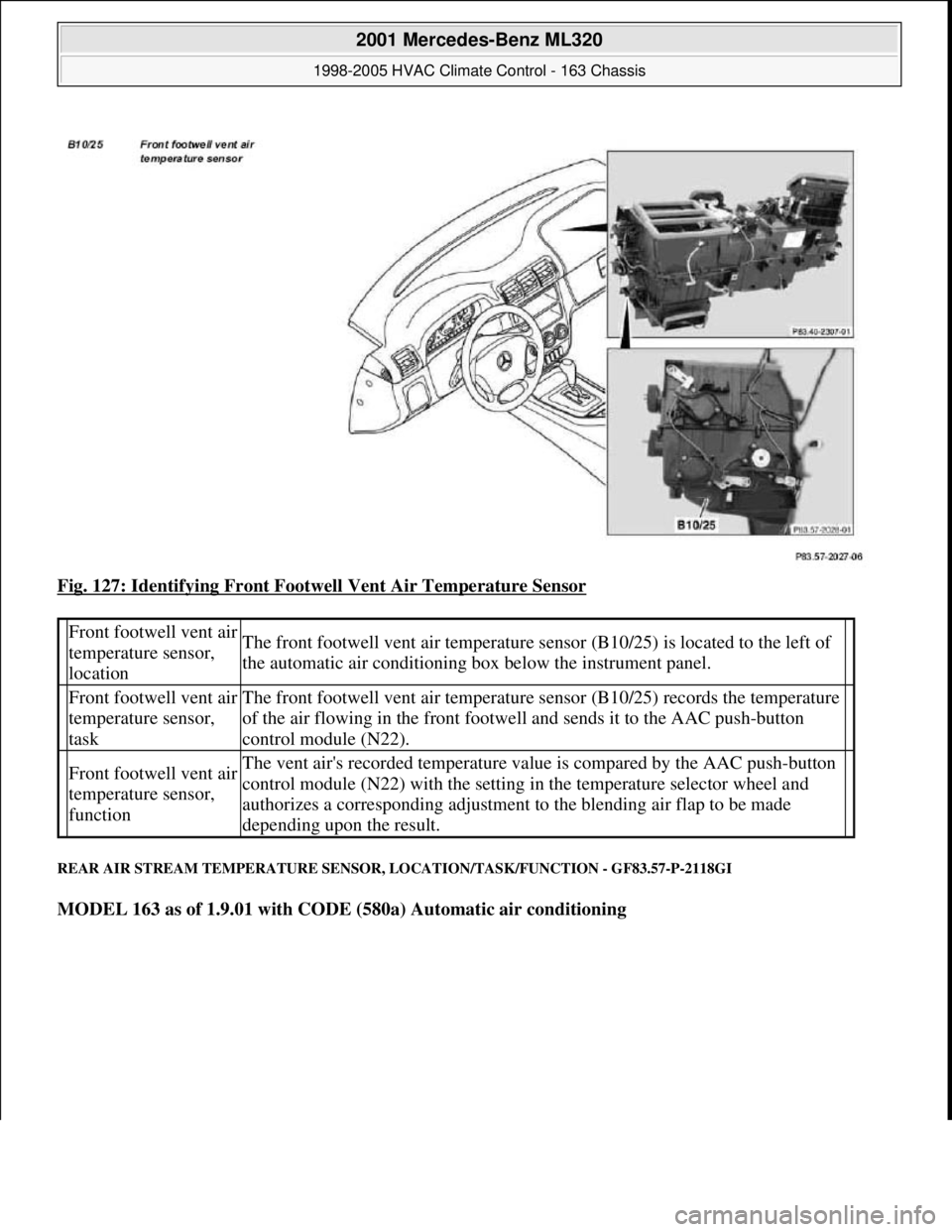
Fig. 127: Identifying Front Footwell Vent Air Temperature Sensor
REAR AIR STREAM TEMPERATURE SENSOR, LOCATION/TASK/FUNCTION - GF83.57-P-2118GI
MODEL 163 as of 1.9.01 with CODE (580a) Automatic air conditioning
Front footwell vent air
temperature sensor,
locationThe front footwell vent air temperature sensor (B10/25) is located to the left of
the automatic air conditioning box below the instrument panel.
Front footwell vent air
temperature sensor,
taskThe front footwell vent air temperature sensor (B10/25) records the temperature
of the air flowing in the front footwell and sends it to the AAC push-button
control module (N22).
Front footwell vent air
temperature sensor,
functionThe vent air's recorded temperature value is compared by the AAC push-button
control module (N22) with the setting in the temperature selector wheel and
authorizes a corresponding adjustment to the blending air flap to be made
depending upon the result.
2001 Mercedes-Benz ML320
1998-2005 HVAC Climate Control - 163 Chassis
me
Saturday, October 02, 2010 3:23:17 PMPage 150 © 2006 Mitchell Repair Information Company, LLC.
Page 3396 of 4133
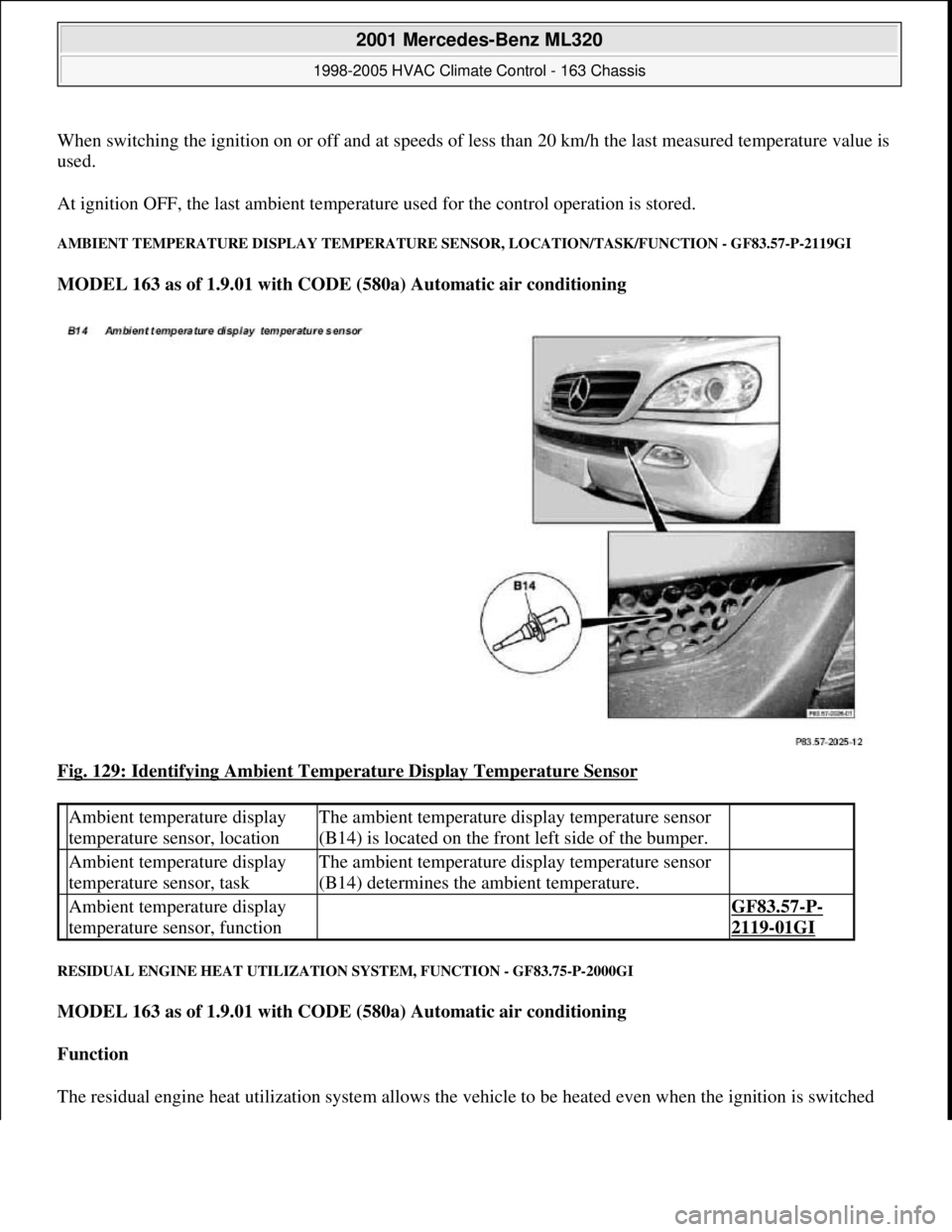
When switching the ignition on or off and at speeds of less than 20 km/h the last measured temperature value is
used.
At ignition OFF, the last ambient temperature used for the control operation is stored.
AMBIENT TEMPERATURE DISPLAY TEMPERATURE SENSOR, LOCATION/TASK/FUNCTION - GF83.57-P-2119GI
MODEL 163 as of 1.9.01 with CODE (580a) Automatic air conditioning
Fig. 129: Identifying Ambient Temperature Display Temperature Sensor
RESIDUAL ENGINE HEAT UTILIZATION SYSTEM, FUNCTION - GF83.75-P-2000GI
MODEL 163 as of 1.9.01 with CODE (580a) Automatic air conditioning
Function
The residual en
gine heat utilization system allows the vehicle to be heated even when the ignition is switched
Ambient temperature display
temperature sensor, locationThe ambient temperature display temperature sensor
(B14) is located on the front left side of the bumper.
Ambient temperature display
temperature sensor, taskThe ambient temperature display temperature sensor
(B14) determines the ambient temperature.
Ambient temperature display
temperature sensor, function GF83.57-P-
2119-01GI
2001 Mercedes-Benz ML320
1998-2005 HVAC Climate Control - 163 Chassis
me
Saturday, October 02, 2010 3:23:17 PMPage 152 © 2006 Mitchell Repair Information Company, LLC.
Page 3397 of 4133
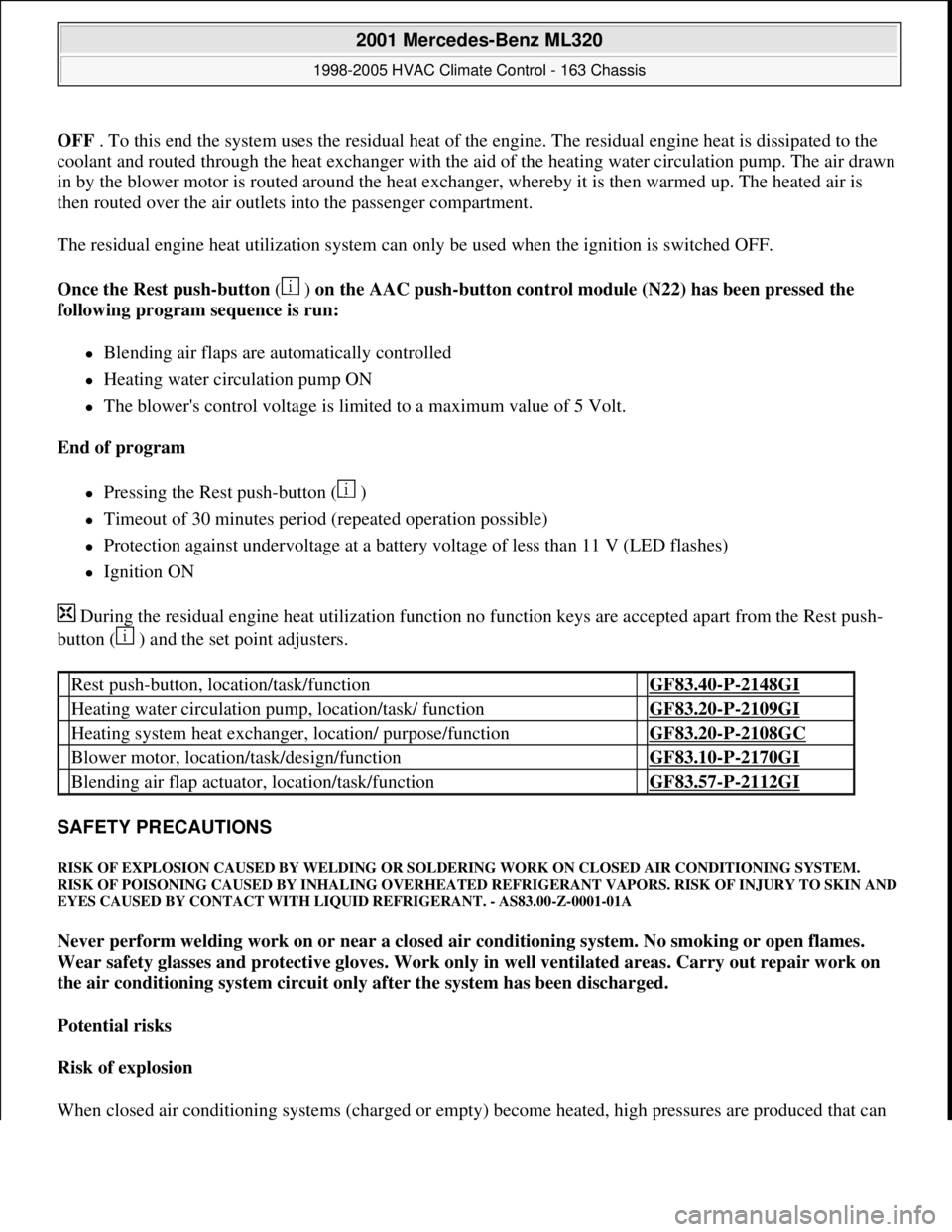
OFF . To this end the system uses the residual heat of the engine. The residual engine heat is dissipated to the
coolant and routed through the heat exchanger with the aid of the heating water circulation pump. The air drawn
in by the blower motor is routed around the heat exchanger, whereby it is then warmed up. The heated air is
then routed over the air outlets into the passenger compartment.
The residual engine heat utilization system can only be used when the ignition is switched OFF.
Once the Rest push-button ( ) on the AAC push-button control module (N22) has been pressed the
following program sequence is run:
Blending air flaps are automatically controlled
Heating water circulation pump ON
The blower's control voltage is limited to a maximum value of 5 Volt.
End of program
Pressing the Rest push-button ( )
Timeout of 30 minutes period (repeated operation possible)
Protection against undervoltage at a battery voltage of less than 11 V (LED flashes)
Ignition ON
During the residual engine heat utilization function no function keys are accepted apart from the Rest push-
button ( ) and the set point adjusters.
SAFETY PRECAUTIONS
RISK OF EXPLOSION CAUSED BY WELDING OR SOLDERING WORK ON CLOSED AIR CONDITIONING SYSTEM.
RISK OF POISONING CAUSED BY INHALING OVERHEATED REFRIGERANT VAPORS. RISK OF INJURY TO SKIN AND
EYES CAUSED BY CONTACT WITH LIQUID REFRIGERANT. - AS83.00-Z-0001-01A
Never perform welding work on or near a closed air conditioning system. No smoking or open flames.
Wear safety glasses and protective gloves. Work only in well ventilated areas. Carry out repair work on
the air conditioning system circuit only after the system has been discharged.
Potential risks
Risk of explosion
When closed air conditionin
g systems (charged or empty) become heated, high pressures are produced that can
Rest push-button, location/task/function GF83.40-P-2148GI
Heating water circulation pump, location/task/ function GF83.20-P-2109GI
Heating system heat exchanger, location/ purpose/function GF83.20-P-2108GC
Blower motor, location/task/design/function GF83.10-P-2170GI
Blending air flap actuator, location/task/function GF83.57-P-2112GI
2001 Mercedes-Benz ML320
1998-2005 HVAC Climate Control - 163 Chassis
me
Saturday, October 02, 2010 3:23:17 PMPage 153 © 2006 Mitchell Repair Information Company, LLC.
Page 3398 of 4133
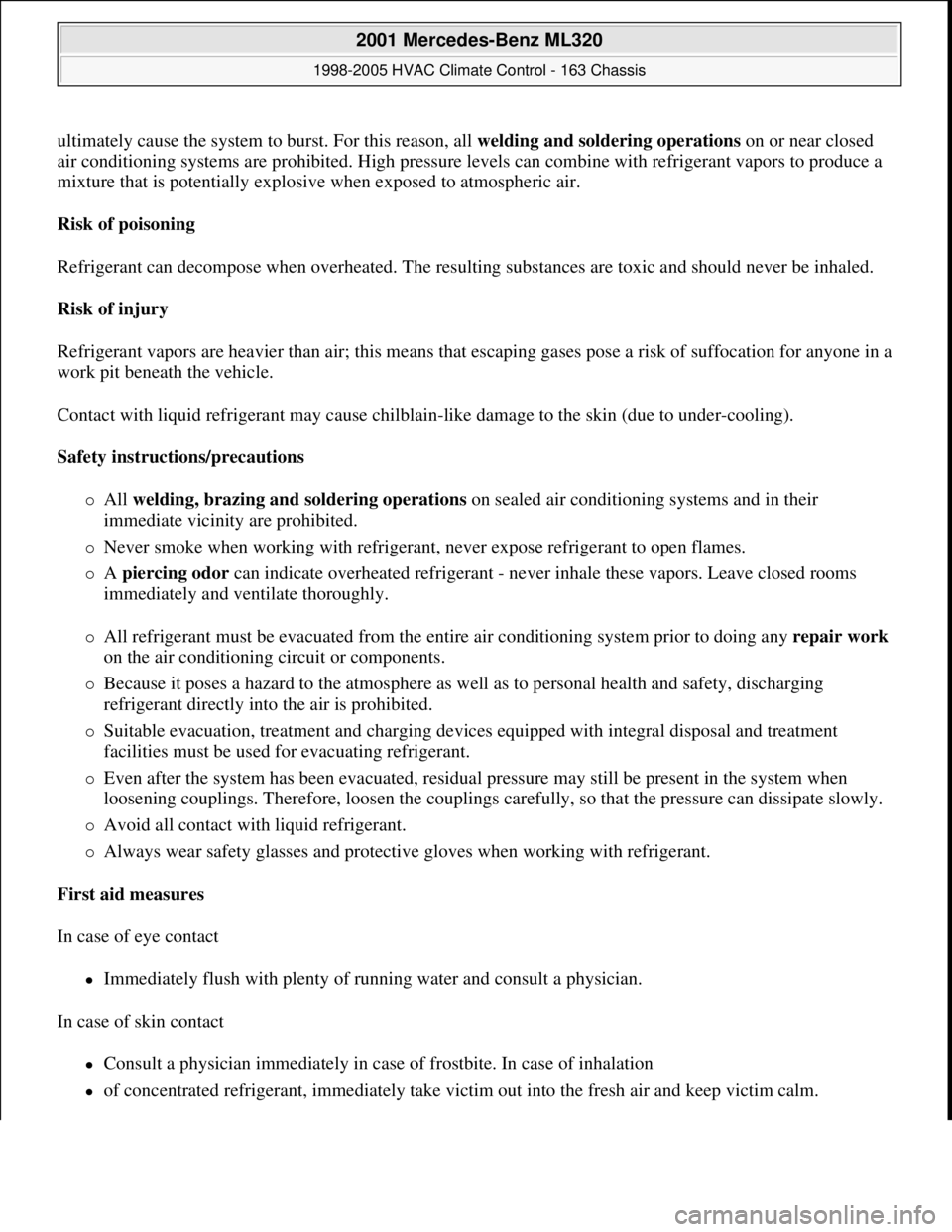
ultimately cause the system to burst. For this reason, all welding and soldering operations on or near closed
air conditioning systems are prohibited. High pressure levels can combine with refrigerant vapors to produce a
mixture that is potentially explosive when exposed to atmospheric air.
Risk of poisoning
Refrigerant can decompose when overheated. The resulting substances are toxic and should never be inhaled.
Risk of injury
Refrigerant vapors are heavier than air; this means that escaping gases pose a risk of suffocation for anyone in a
work pit beneath the vehicle.
Contact with liquid refrigerant may cause chilblain-like damage to the skin (due to under-cooling).
Safety instructions/precautions
All welding, brazing and soldering operations on sealed air conditioning systems and in their
immediate vicinity are prohibited.
Never smoke when working with refrigerant, never expose refrigerant to open flames.
A piercing odor can indicate overheated refrigerant - never inhale these vapors. Leave closed rooms
immediately and ventilate thoroughly.
All refrigerant must be evacuated from the entire air conditioning system prior to doing any repair work
on the air conditioning circuit or components.
Because it poses a hazard to the atmosphere as well as to personal health and safety, discharging
refrigerant directly into the air is prohibited.
Suitable evacuation, treatment and charging devices equipped with integral disposal and treatment
facilities must be used for evacuating refrigerant.
Even after the system has been evacuated, residual pressure may still be present in the system when
loosening couplings. Therefore, loosen the couplings carefully, so that the pressure can dissipate slowly.
Avoid all contact with liquid refrigerant.
Always wear safety glasses and protective gloves when working with refrigerant.
First aid measures
In case of eye contact
Immediately flush with plenty of running water and consult a physician.
In case of skin contact
Consult a physician immediately in case of frostbite. In case of inhalation
of concentrated refrigerant, immediately take victim out into the fresh air and keep victim calm.
2001 Mercedes-Benz ML320
1998-2005 HVAC Climate Control - 163 Chassis
me
Saturday, October 02, 2010 3:23:17 PMPage 154 © 2006 Mitchell Repair Information Company, LLC.